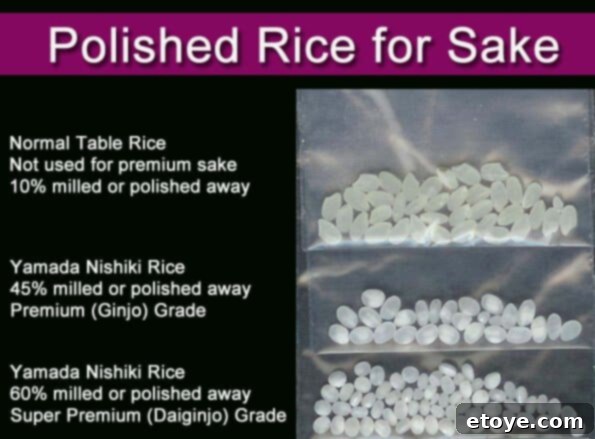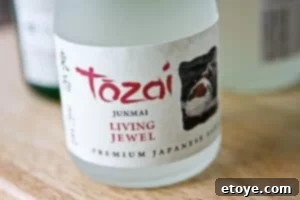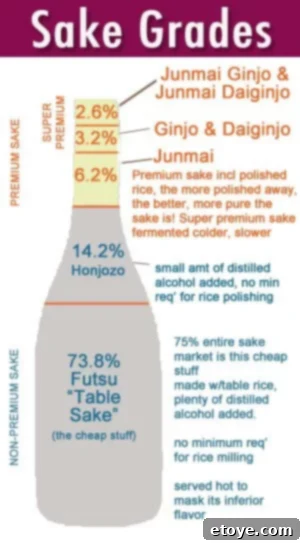
Discovering the Refined World of Premium Japanese Sake
While my appreciation for Asian culture runs deep, my true immersion into the intricate and elegant world of fine Japanese sake (pronounced SAH-keh) is a relatively recent journey. Just over a year ago, serendipity led me to a private tasting session hosted by Morgan Hartman, a knowledgeable sake sales representative from Vine Connections. This unique opportunity, initially intended for a local restaurant’s staff, became a captivating introduction to the artistry of artisan sake, profoundly shifting my perspective on this traditional Japanese beverage.
The experience was nothing short of mind-blowing. We sampled eight or nine distinct brands of sake, each offering a unique sensory profile. Unlike professional wine tasters who might utilize a spit bucket, I found myself unable to part with a single drop, completely captivated by the nuanced flavors. This tasting transcended mere consumption; it was an educational revelation, unveiling the depth and complexity that premium sake offers.
A quick note on tasting etiquette: For those unfamiliar with professional wine tastings, experts often swirl, sniff, and taste the wine without swallowing. This practice helps prevent palate fatigue and intoxication, especially when sampling numerous varieties. However, in my personal experience, truly appreciating the full spectrum of an exceptional beverage often involves savoring every sip. While some possess an uncanny ability to discern obscure notes like “pencil lead” or “cat piss,” my enjoyment stems more from the overall experience and the harmonious blend of flavors. And honestly, the only time I’d ever seek a “leather” aroma is perhaps while riding on the back of Fonzie’s motorcycle – a fleeting, nostalgic thought!
The tasting event showcased nine artisan sakes sourced from diverse regions across Japan. Each bottle was a testament to handcrafted brewing methods and the use of premium ingredients. Remarkably, these sakes were free from chemicals and sulfites, with some even crafted without the aid of modern machinery, preserving ancient traditions. While a few selections were on the pricier side, the majority were surprisingly affordable, comparable to a good everyday bottle of wine. This discovery delightfully debunked the common misconception that quality sake must always break the bank.
Over the coming weeks, I am excited to share a wealth of information about Japanese sake, specifically focusing on the exceptional varieties best enjoyed chilled, much like fine wine. This is a stark contrast to the often-misunderstood practice of serving cheap, lower-quality sake heated. Heating inferior sake typically serves to mask its less desirable flavors, making the heat itself the dominant sensation rather than the true taste of the beverage. My initial tasting experience completely transformed my perception; I now find it challenging to appreciate hot sake at all. It’s a common misconception that all sake should be served warm, but for true premium sake, a chilled serving temperature allows its delicate aromas and intricate flavors to shine through beautifully.
My immersion into the world of sake has been rigorous, fueled by late-night “market research” tasting sessions. My primary educators and sponsors for this sake journey are the experts at Vine Connections. Based in California, this esteemed company represents over 20 of Japan’s finest premium sake breweries. These artisan producers, many of whom are traditional family brewers with legacies spanning over 80 years, craft some of the most exquisite sake available. I’ve been fortunate to learn from Morgan, Lisa, Ed, and Jeffrey, who will be collaborating with me to bring you comprehensive insights. Together, we’ll delve into the fundamentals of premium sake, guide you on how to order and decipher labels, provide detailed tasting notes, explore the art of food and sake pairing, and even teach you how to host your own artisan sake tasting event with friends.
What Defines Premium Japanese Sake? The Drink of the Gods
Sake, often revered in Japan as the “Drink of the Gods,” is a sophisticated alcoholic beverage traditionally crafted from sake-specific rice varieties, pristine water, koji mold spores, and carefully selected yeasts. Unlike popular perception, premium sake is not a spirit or a wine in the conventional sense. Instead, its brewing process shares fascinating similarities with beer, yet its intricate flavor profiles and refined drinking experience are often likened to fine wine.
The brewing process begins with the conversion of starch to sugar, a step analogous to beer production. This sugar is then fermented into alcohol. However, much like fine wines, each premium sake brand boasts its own distinct tasting notes and aromatic qualities. Some sakes present with earthy, woodsy undertones, making them an excellent complement to richer meats and other full-flavored dishes. Others delight the palate with bright, fruity notes of lychee and lemon zest, pairing exquisitely with steamed seafood or delicate appetizers.

So, what truly elevates a sake to the “premium” designation? Imagine comparing a single malt Scotch or a high-quality agave tequila to their mass-produced counterparts. Premium Japanese sake stands in a similar league. The brewers behind these exceptional sakes are typically family-run artisan craftsmen, dedicated to traditional methods. Their sake is predominantly handmade, with minimal, if any, automation. This commitment to quality means no shortcuts: no cheap rice, no mass-production techniques, and crucially, no chemical additives. This artisanal approach ensures a purity of flavor and a depth of character that defines the premium experience.
Beyond its exquisite taste, premium sake offers several appealing characteristics. It is naturally gluten-free, sulfite-free, and often certified kosher, making it a versatile choice for a wider audience. Its popularity is surging, with the U.S. market experiencing an impressive 20% annual growth rate over the past five years. This burgeoning interest has also led to innovative new products, such as sparkling Japanese sake infused with all-natural Asian flavors. Served chilled and often presented elegantly in a champagne flute, sparkling sake offers a refreshing and sophisticated alternative.
The Foundation of Flavor: It All Begins with the Rice
The journey to crafting exceptional sake fundamentally begins with the rice, but not just any rice. While a grain of rice may seem small, the secret to premium sake lies in an intensive process called “rice polishing” or “milling.” This meticulous procedure removes the outer layers of each rice grain, leaving behind only the pure, starchy heart, known as the shinpaku. It is this concentrated core that yields the cleanest, purest, most fragrant, and complex-tasting sake imaginable.
So, what exactly are we polishing away, and why is it detrimental to sake fermentation? The outer layers of a rice grain contain:
- Proteins
- Minerals
- Fats
- Amino acids
- Other “unwanted cling-ons”
While these components are beneficial for human consumption (when eating rice), they can introduce undesirable flavors and impurities during the sake fermentation process. These elements can lead to off-flavors, bitterness, or an overly robust character that detracts from the desired elegance and purity of premium sake.
Consequently, the more the rice is milled and polished, the cleaner, more elegant, and refined the resulting sake becomes. Cheaper sakes often utilize less polished rice, sometimes even the entire grain, which contributes to their harsher, less nuanced profiles. In stark contrast, super-premium sakes are frequently crafted using specialized sake rice varieties, such as Yamada Nishiki. This particular rice, renowned for its large, soft grains and prominent shinpaku, is often polished to an astonishing 40% of its original size, meaning 60% of the grain has been carefully removed! This extreme polishing level is a hallmark of the highest quality sakes, visibly demonstrating how the milled grain transforms into a smaller, whiter, and purer core compared to table rice.

Decoding Sake Labels: Essential Japanese Terminology
Just as wine connoisseurs distinguish between Merlot, Pinot Noir, or Chardonnay, understanding a few key Japanese terms is crucial for navigating the world of premium sake. These terms primarily indicate the rice polishing ratio and whether distilled alcohol has been added, offering vital clues about the sake’s quality and style.
Junmai (JOON-mai): The Pure Rice Expression
The term “Junmai” literally translates to “pure rice.” This classification signifies sake brewed exclusively from rice, water, yeast, and koji (the unique mold that converts rice starch into fermentable sugars). Crucially, Junmai sake is produced without any added distilled alcohol. While some lower-grade sakes might include distilled alcohol to expedite fermentation and increase yield, Junmai adheres strictly to a natural fermentation process, prioritizing purity and flavor integrity. Generally, Junmai sakes tend to be a bit heavier and fuller-bodied, often exhibiting a slightly higher acidity. Their robust profile makes them incredibly versatile and a great match for a wide range of foods. To qualify as Junmai, the rice grains must be polished to at least 70% of their original size, meaning a minimum of 30% of the outer grain has been polished away.
Ginjo (GEEN-joe): The Super-Premium Craft
Ginjo represents a super-premium class of sake, characterized by a more intensive and meticulous brewing process. This includes higher rice milling rates, the exclusive use of special sake rice varieties and specific yeast strains, extended fermentation periods at cooler temperatures, and numerous other labor-intensive techniques. The result is a sake with a heightened aromatic profile, often more fragrant and refined than standard Junmai. Ginjo sakes typically have a minimum rice polishing ratio of 60% (meaning at least 40% removed).
Daiginjo (die-GEEN-joe): The Pinnacle of Refinement
Daiginjo represents the absolute pinnacle of sake craftsmanship, demanding an even more painstaking and precise brewing process than Ginjo. This results in sakes that are exceptionally light, exquisitely fragrant, and often display delicate, fruity notes. To earn the Daiginjo classification, the rice must be milled to at least 50% of its original size. However, it’s not uncommon for Daiginjo sakes to push this boundary further, using rice polished down to an incredible 35% of its original size, signifying that a remarkable 65% of the outer kernel has been meticulously polished away. This extreme dedication to purity and refinement creates a sake of unparalleled elegance.
These terms can also be combined to denote even finer categories. For instance:
 Junmai: Pure rice sake, no distilled alcohol added, rice milled to at least 70% (30% polished away).
Junmai: Pure rice sake, no distilled alcohol added, rice milled to at least 70% (30% polished away).
 Junmai Ginjo: Super-premium pure rice sake, no distilled alcohol added, rice milled to at least 60% (40% polished away).
Junmai Ginjo: Super-premium pure rice sake, no distilled alcohol added, rice milled to at least 60% (40% polished away).
 Junmai Daiginjo: The very finest pure rice sake, no distilled alcohol added, rice milled to at least 50% (50% polished away), often even more.
Junmai Daiginjo: The very finest pure rice sake, no distilled alcohol added, rice milled to at least 50% (50% polished away), often even more.
Visualizing Sake Grades

Percentages from Sake World
Beyond the Bottle: Pairing, Serving, and Enjoying Artisan Sake
The journey into premium sake extends far beyond simply understanding its grades and origins; it encompasses the delightful art of pairing it with food, serving it correctly, and appreciating its nuanced flavors. These elements are key to unlocking the full potential of artisan sake and transforming a simple drink into a memorable culinary experience.
The Art of Food and Sake Pairing
Unlike wine, whose tannins and acidity can sometimes clash with certain dishes, sake’s gentler profile and higher amino acid content make it incredibly versatile for food pairing. The goal is to create harmony, balancing flavors rather than overpowering them. For instance, a light, fragrant Junmai Ginjo with fruity notes pairs exquisitely with delicate steamed fish, sushi, or fresh salads. Its subtle sweetness and clean finish enhance, rather than compete with, the food’s natural flavors. On the other hand, a more robust and earthy Junmai, with its richer umami characteristics, can stand up beautifully to grilled meats, hearty stews, or even some cheeses. The rule of thumb is often to match the intensity of the sake with the intensity of the dish. Sake’s unique ability to cleanse the palate between bites also makes it an excellent accompaniment throughout an entire meal, from appetizers to main courses.
How to Serve Sake for Optimal Enjoyment
As we’ve explored, the notion that all sake should be served hot is a significant misconception, especially for premium varieties. For artisan sake, the ideal serving temperature is almost always chilled, similar to white wine, typically between 40-50°F (5-10°C). This cooler temperature allows the delicate aromatics, intricate flavors, and refined structure of premium sake to fully express themselves. Heating a premium sake can mute its nuanced characteristics and accentuate any less desirable notes. While some traditional, richer, or older sakes might be enjoyed at room temperature or even slightly warmed, it’s generally best to start chilled and experiment if desired. Using appropriate glassware, such as a wine glass or a traditional sake cup (guinomi or ochoko), can also significantly enhance the tasting experience, allowing the aromas to gather and present beautifully.
Reading Sake Labels and Navigating Your Choices
Understanding a sake label can seem daunting at first, but with a few key pieces of information, it becomes a roadmap to discovering your next favorite bottle. Beyond the Junmai, Ginjo, and Daiginjo classifications, labels often include details like the brewery name, the region of production, the specific rice variety used, and the Sake Meter Value (SMV), which indicates sweetness or dryness. Alcohol percentage, bottling date, and whether the sake is pasteurized (nama) or unpasteurized also offer valuable insights. Learning to interpret these elements empowers you to make informed selections, tailored to your palate and the occasion.
Our upcoming features will delve deeper into each of these fascinating aspects, providing you with the tools and knowledge to confidently explore and appreciate the world of artisan sake. We’ll offer full tasting notes on specific sakes like Living Jewel, Divine Droplets, Wandering Poet, and Snow Maiden, guiding you through their unique profiles and ideal pairings. Join us as we continue to uncover the rich traditions and exquisite craftsmanship behind Japan’s “Drink of the Gods.”